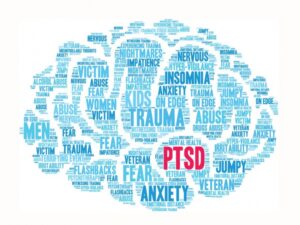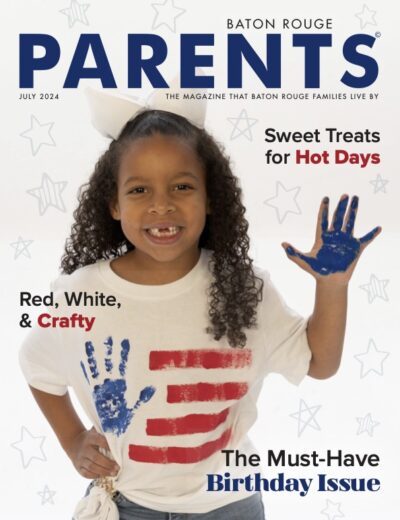
After the Trauma: Coping with Post-Traumatic Stress Disorder
“My counselor explained that having PTSD is like having a sniper on the watch tower in your brain. Every single sound, thought, emotion, anything, is a perceived threat. My brain was stuck in that,” shares local mom Candice P., who lives with Post-Traumatic Stress Disorder (PTSD).
The American Psychiatric Association describes PTSD as a “disorder that may occur in people who have experienced or witnessed a traumatic event such as a natural disaster, a serious accident, a terrorist act, war/combat, or rape, or who have been threatened with death, sexual violence or serious injury.”
In the last few years, Baton Rouge has dealt with a major flooding event, shootings, named storms, and COVID-19. Any of these events, as well as events in personal lives, can cause a PTSD response.
Local mom Emma C. shares, “I think it is fair to say that everyone lost something last year. We lost our sense of familiarity, predictability, and routine. Some lost their health, jobs, homes, or people they love.”
Tara Dixon, a mental health counselor and owner of Heal Your Life Counseling, LLC., adds, “In an instant, our world as we knew it stopped. If you have ever struggled with mental illness, you know that idle time does no favors for disturbing thoughts. It’s easy to understand how someone struggling with PTSD would fall into negative thought patterns when given ample time to ruminate on past events. Lockdown was a perfect storm of idle time, isolation, and increased uncertainty…all triggers of PTSD.”
UNDERSTANDING PTSD
Anyone can be affected by PTSD as the condition does not discriminate based on age, race, ethnicity, gender, or other bias. In fact, Americans have a 1 in 11 chance of being diagnosed with PTSD in their lifetime, and that doesn’t include people who don’t seek help. Some studies indicate that up to 50 percent of people suffering with PTSD do not seek treatment. In adults, about half of those with PTSD also suffer with substance abuse problems.
“There have been a multitude of studies exploring the onset of PTSD following a natural disaster,” Dixon reports. “One of the first major studies on this topic was conducted in our own backyard following Hurricane Katrina in 2005. After four years of tracking, it was determined that 33 percent of survivors were diagnosed with PTSD. There is no doubt that COVID will produce similar, if not worse, results. And, unfortunately, our children are extremely vulnerable to the effects of PTSD.”
KNOWING THE SIGNS
“Some symptoms that you can watch for are large changes in sleeping routines (too much or too little sleep), unwarranted grouchiness or irritability, consistent nervous or jittery movements, an increase in aggression, fixation on death and dying, reverting back to infant behaviors such as thumb-sucking or bedwetting, and consistent physical symptoms such as headaches or stomaches,” Dixon continues.
Other signs and symptoms include: reliving the event either in thoughts or in play; nightmares; becoming agitated when the event is mentioned or denying the event ever occurred; avoiding people or places associated with the event; a sense of helplessness or hopelessness; and intense ongoing feelings of fear, sadness, or anger. People suffering with PTSD may experience feelings of distrust, depression, self-blame, panic attacks, migraines, back pain, or weight loss. Emily T., who is 13 and has PTSD, says, “When I’m triggered, I’m overwhelmed and have trouble breathing.”
TREATING PTSD
Candice shares that just speaking about her PTSD conjures anxiety and some panic. However, she continues, “I guess the first thing in dealing with it is to recognize it happening and slowly remind yourself you are in a safe place.”
When Emily is triggered, she reaches out for help. “I find a trusted adult to help me know that I’m safe and to help me calm down.”
It’s also important that you speak with your healthcare provider or mental health counselor. People, especially children, may find it very difficult to talk about the event that has caused PTSD. Therapies in which children can draw, sculpt, play, or write about the stressful event can be very therapeutic.
Emma adds, “Our two daughters started therapy for the loss of both of their grandfathers. Therapy was really helpful for our family. I’m glad that the stigma surrounding mental health and caring for mental health seems to be diminishing from when I was a kid.”
It should be known though that PTSD cannot be cured. “Although PTSD cannot be cured, it can be treated,” shares Dixon. “Cognitive Behavioral Therapy and Dialectical Behavior Therapy have provided the best results in treating PTSD in both children and adults. Both forms of therapy place great focus on emotional regulation, a key component to managing PTSD.”
LIVING WITH PTSD
“I’m much better now, but it never goes away. Now when symptoms happen, I just stop and try to breathe. If I need to cry, I do, but I try not to stay in that place too long,” shares Candice. “I do a tiny bit of yoga almost every morning and it helps to start my day on my terms.”
If you or someone you know has concerns about PTSD, or if you may be experiencing signs of PTSD, always reach out to your healthcare provider.





